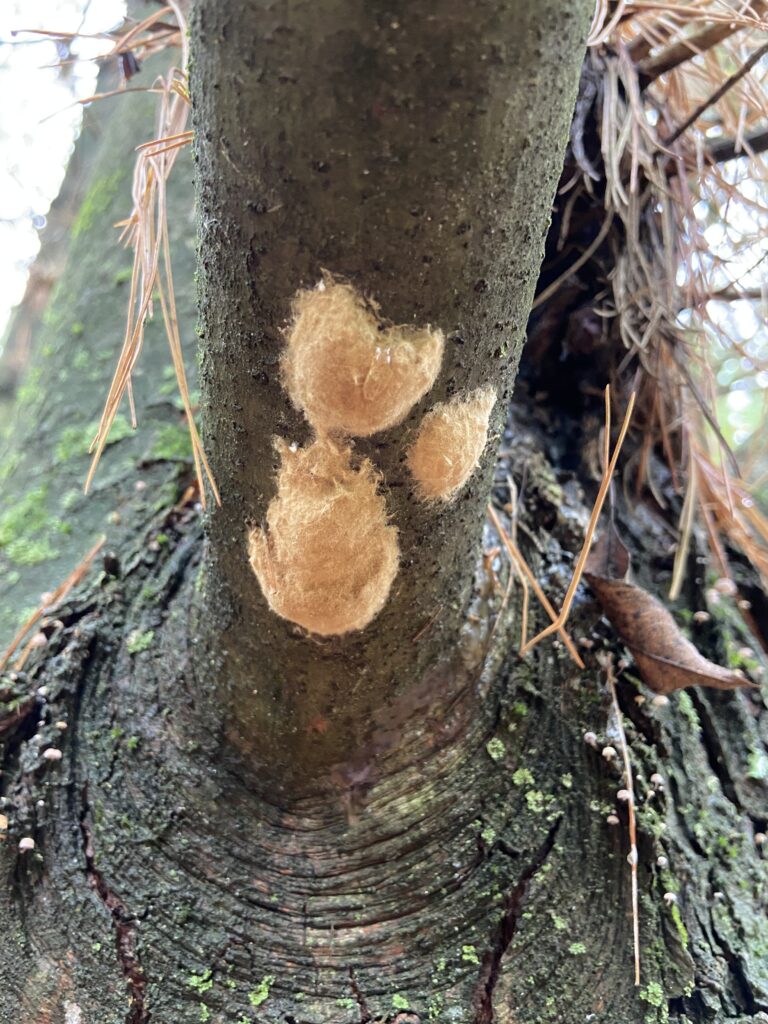By Bill McNee, DNR Forest Health Specialist, Oshkosh, Bill.McNee@wisconsin.gov or 920-360-0942
Spongy moth (formerly known as gypsy moth) egg masses typically begin to hatch in April as temperatures warm. Each mass that hatches may produce up to 1,000 leaf-eating caterpillars.
Now is a great time to inspect your trees for egg masses and treat or remove any masses within reach. Wisconsin weather has been favorable for this pest over the last three years and populations have grown.

Three spongy moth egg masses on the underside of a pine branch in Walworth County. Photo: Bill McNee, Wisconsin DNR.
Egg masses are tan-colored lumps about the size of a nickel or a quarter. They can be found on trees, buildings and other outdoor objects. Egg masses are often found in sheltered places such as firewood piles and the inside of bird houses. The highest populations and most rapid population increases are usually found where oaks and other preferred species are growing on mowed lawns, street terraces or sandy soil. A survey method for predicting the level of this summer’s defoliation can be found on Wisconsin’s spongy moth portal.
If egg masses are found, there are two options to help reduce pest numbers prior to egg hatch. Horticultural oils can be directly sprayed on the egg masses to suffocate them. These oils are typically applied when temperatures are above 40 degrees and not expected to dip below freezing for a few days. Adding a little food coloring to the spray mix helps identify the treated masses and shows that oiling has been done. A second method is to scrape egg masses into a can of soapy water and leave them to soak for a few days before throwing them in the trash. When choosing this method, target egg masses that were produced during the previous summer. Older masses that are faded and feel spongy do not contain viable eggs and do not need to be oiled or removed.
Bacterial or chemical insecticide treatments may be appropriate for larger trees with many egg masses. Insecticide treatments are usually most effective when done while the caterpillars are small (mid- to-late May in southern counties and late May-early June in northern counties). Treatments include foliage sprays, soil injections and trunk injections. Physical controls such as sticky bands and burlap collection bands may be sufficient to prevent heavy defoliation as long as the egg mass numbers are not too high.
Arranging for insecticide treatments ahead of time can secure an applicator, as well as avoid a last-minute rush when pesticide application businesses may already be very busy. Resources for finding a qualified pesticide applicator include the Wisconsin Arborist Association, International Society of Arboriculture and a local phone book.
Host trees enduring heavy defoliation and/or drought stress in 2022 are at elevated risk for mortality if defoliated in 2023 and will often need insecticide protection. Untreated, low-vigor oak trees will usually be infested by twolined chestnut borer (a native beetle). Consult an arborist or forester.
Visit Wisconsin’s spongy moth portal for additional information on egg mass oiling and removal, physical controls and insecticide application. A map of quarantined counties shows where the pest is considered to be “generally established.”
